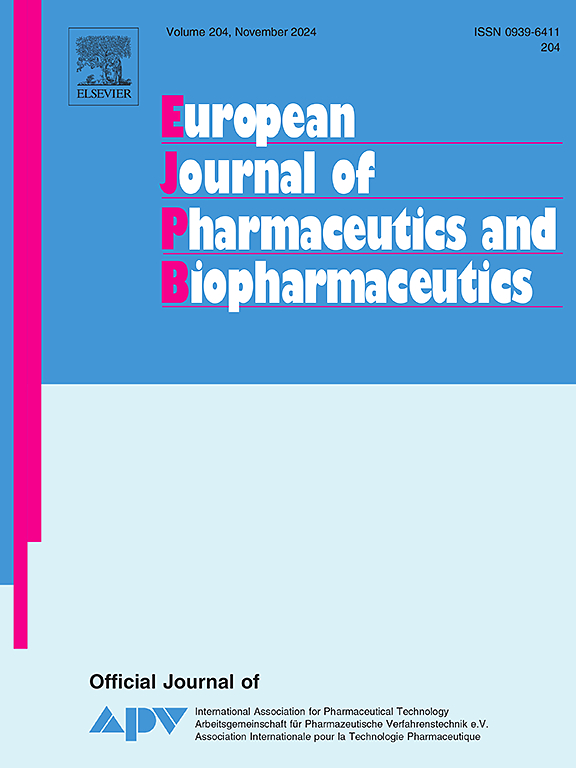A comprehensive mechanistic investigation of factors affecting intestinal absorption and bioavailability of two PROTACs in rats
IF 4.4
2区 医学
Q1 PHARMACOLOGY & PHARMACY
European Journal of Pharmaceutics and Biopharmaceutics
Pub Date : 2025-04-12
DOI:10.1016/j.ejpb.2025.114719
引用次数: 0
Abstract
Aim
Proteolysis targeting chimeras (PROTACs) exhibit a unique and promising pharmacology. However, this comes with molecular properties exceeding the ‘drug-like’ rule of five chemical space, which often limits gastrointestinal absorption. This in vivo study aimed to investigate the contribution of luminal and plasma stability, intestinal effective permeability, P-glycoprotein (P-gp) efflux, and bile excretion, on the rat intestinal absorption and systemic exposure of two PROTACs, ARV-110 (812 Da, LogD7.4 4.8) and ARV-471 (724 Da, LogD7.4 4.6).
Methods
Luminal stability and effective intestinal permeability were determined directly from luminal disappearance using single-pass intestinal perfusion, with and without a protease inhibitor, or a P-gp/Cytochrome P450 CYP3A inhibitor (ketoconazole) in rats. Plasma stability was tested by in vitro incubations. Intestinal absorption, systemic exposure, and biliary excretion were examined after intraduodenal and intravenous dosing with ketoconazole or the P-gp selective inhibitor (encequidar).
Results and discussion
Both PROTACs were degraded in the intestinal lumen and in plasma by peptidases. The intestinal effective permeability in rats was moderate for ARV-110 (0.62 × 10-4 cm/s) and low for ARV-471 (0.23 × 10-4 cm/s). P-gp inhibition increased the permeability 1.6- and 2.3-fold for ARV-110 and ARV-471, respectively. After intraduodenal dosing with the P-gp inhibitors a corresponding increase in systemic exposure was observed for both PROTACs. There was only a minor difference in the increased systemic exposure induced by the two inhibitors, suggesting that the mechanisms were primarily P-gp inhibition, rather than gut-wall and hepatic extraction. Biliary excretion was a minor pathway and did not affect the absorption and systemic exposure of the PROTACs to a large extent.
Conclusion
In the rat, ARV-110 and ARV-471 were enzymatically degraded in the intestinal lumen and in plasma, and their intestinal permeability and systemic exposure seem to be reduced due to P-gp efflux.

影响两种PROTACs大鼠肠道吸收和生物利用度因素的综合机制研究
靶向嵌合体(proteolysis targeting chimeras, PROTACs)具有独特的药理作用。然而,它的分子特性超过了五种化学空间的“类药物”规则,这通常会限制胃肠道的吸收。本体内研究旨在探讨肠道和血浆稳定性、肠道有效通透性、p -糖蛋白(P-gp)外排和胆汁排泄对ARV-110 (812 Da, LogD7.4 4.8)和ARV-471 (724 Da, LogD7.4 4.6)两种PROTACs大鼠肠道吸收和全身暴露的影响。方法采用单次肠道灌注法,分别给药和不给药P-gp/细胞色素P450 CYP3A抑制剂(酮康唑),直接测定大鼠肠道稳定性和有效肠通透性。通过体外培养检测血浆稳定性。在十二指肠内和静脉给药酮康唑或P-gp选择性抑制剂(恩克西达)后,检查肠道吸收、全身暴露和胆汁排泄。结果与讨论两种PROTACs均可通过肽酶在肠腔和血浆中降解。ARV-110对大鼠肠道有效通透性中等(0.62 × 10-4 cm/s), ARV-471对大鼠肠道有效通透性较低(0.23 × 10-4 cm/s)。P-gp抑制作用使ARV-110和ARV-471的通透性分别增加1.6倍和2.3倍。在十二指肠内给药P-gp抑制剂后,观察到两种PROTACs的全身暴露量相应增加。两种抑制剂引起的全身暴露增加只有微小差异,表明其机制主要是P-gp抑制,而不是肠壁和肝脏提取。胆道排泄是次要途径,在很大程度上不影响PROTACs的吸收和全身暴露。结论在大鼠体内,ARV-110和ARV-471在肠腔和血浆中被酶降解,其肠通透性和全身暴露量可能因P-gp外排而降低。
本文章由计算机程序翻译,如有差异,请以英文原文为准。
求助全文
约1分钟内获得全文
求助全文
来源期刊
CiteScore
8.80
自引率
4.10%
发文量
211
审稿时长
36 days
期刊介绍:
The European Journal of Pharmaceutics and Biopharmaceutics provides a medium for the publication of novel, innovative and hypothesis-driven research from the areas of Pharmaceutics and Biopharmaceutics.
Topics covered include for example:
Design and development of drug delivery systems for pharmaceuticals and biopharmaceuticals (small molecules, proteins, nucleic acids)
Aspects of manufacturing process design
Biomedical aspects of drug product design
Strategies and formulations for controlled drug transport across biological barriers
Physicochemical aspects of drug product development
Novel excipients for drug product design
Drug delivery and controlled release systems for systemic and local applications
Nanomaterials for therapeutic and diagnostic purposes
Advanced therapy medicinal products
Medical devices supporting a distinct pharmacological effect.

 求助内容:
求助内容: 应助结果提醒方式:
应助结果提醒方式:


